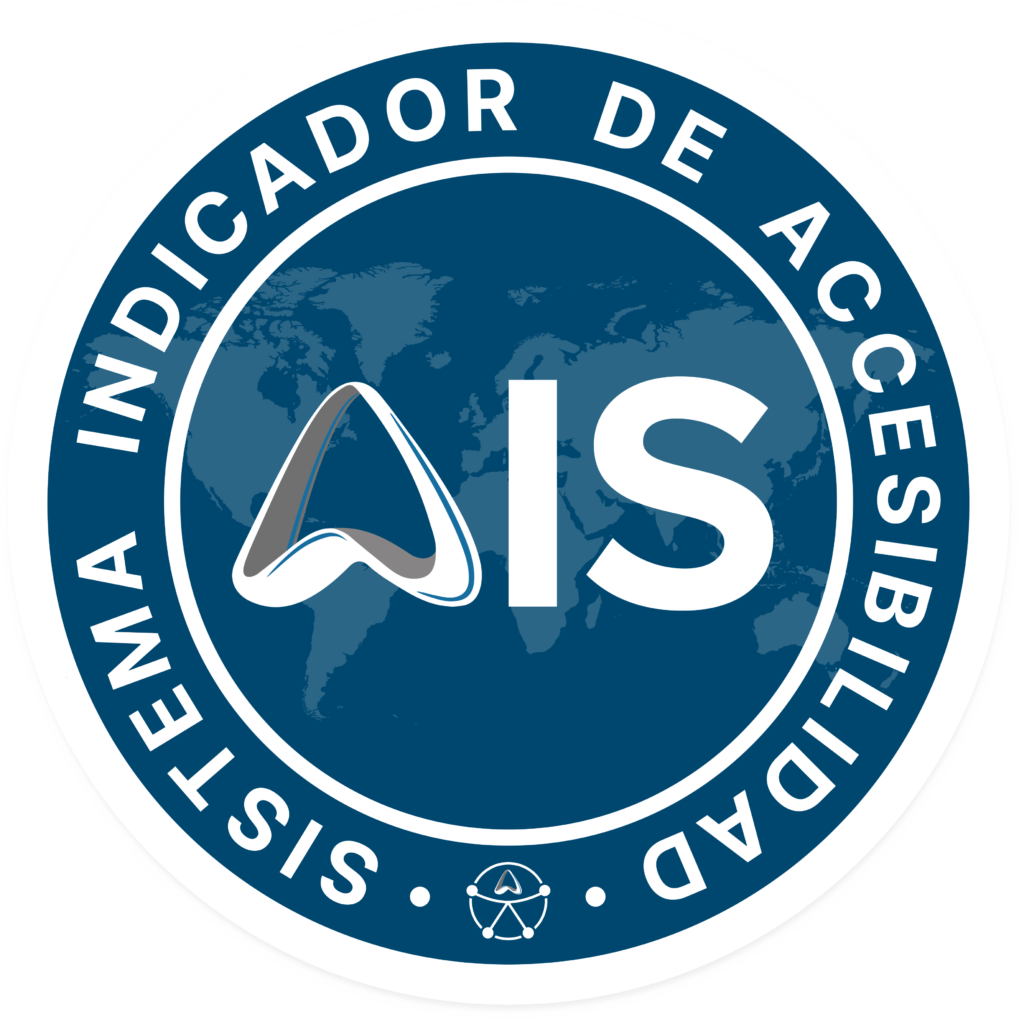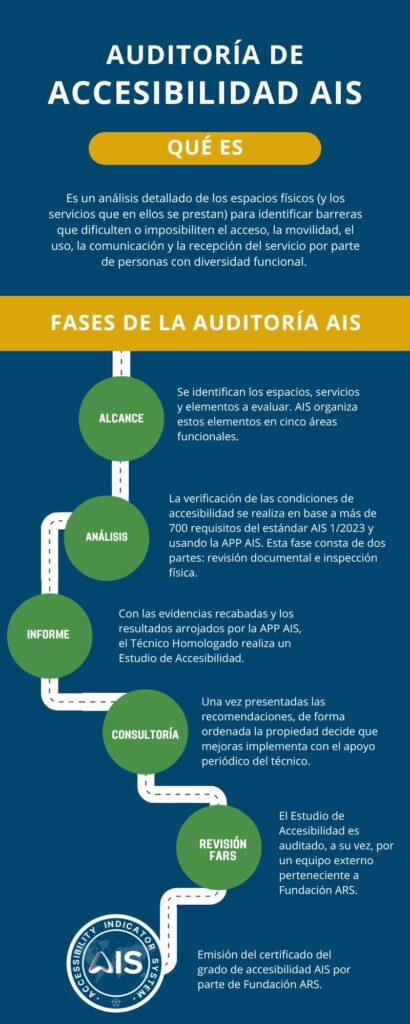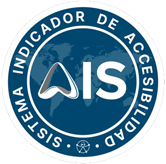A physical space accessibility audit assesses whether the built environment (such as buildings, urban planning, public and private spaces), and the services provided in them, are designed and adapted for use by all people, including those with physical, sensory or cognitive disabilities. This process ensures compliance with regulations, promotes social inclusion and fosters accessible environments for all.
The AIS certification process includes carrying out an accessibility audit based on the AIS 1/2023 standard, which includes and organises into five levels or degrees the international and national regulations of all the countries in which it is certified, UNEs, ISOs, codes of good practice…
Thus, the AIS accessibility audit is a detailed analysis of physical spaces (and the services provided in them) to identify barriers that hinder or prevent access, mobility, use, communication and reception of the service offered in that space by people with functional diversity.

What is an accessibility audit with AIS?
This process consists of different phases, which in the case of AIS are:
- Definition of the scope: The spaces, services and elements to be assessed are identified. AIS organises these elements into five functional areas:
- Horizontal route: This studies the horizontal movement towards the main and secondary services. E.g.: doors and passage openings; pavements; fords, traffic islands and cycle lanes; signs and signals…
- Vertical route: This takes into account mobility in the face of differences in height of more than 55 centimetres and the mechanisms to achieve this movement autonomously. E.g.: lifts; ramps; stairs; other unevenness; lifts and stairlifts…
- Services: Analyses the conditions under which specific services are offered, whether primary or secondary. E.g.: toilet facilities; parking and transport services…
- Communication and Information: It studies the elements that favour the orientation, information and communication to the user in order to guarantee the provision of the service. E.g.: service points (counters); call points (intercoms, buzzers…); signs and signals in conventional or alternative formats…
- Evacuation: Elements that allow the user to carry out a safe evacuation in an autonomous or assisted manner in case of emergency. E.g.: emergency plan; safe spaces; alarm and extinguishing elements; specific measures contemplated in the P.E. and PAU.
- Analysis: The verification of the accessibility conditions of the space is carried out on the basis of the more than 700 requirements of the AIS 1/2023 standard and using an efficient tool created for this purpose: the AIS APP.
- Documentary review: Includes plans, management documents, emergency plans, etc.
- Physical inspection: Field Technicians and Approved Technicians inspect and measure the elements of the physical space, taking photos and evidence.
- Report of results: With the evidence gathered and the results produced by the APP AIS, the Approved Technician carries out an Accessibility Study, which includes:
- Characteristics of the space and context.
- The aspects that comply with the AIS Standard and the level of accessibility to which they correspond among the five grades of the standard.
- Requirements to be met to improve accessibility.
- Consultancy: Once the recommendations have been presented, the property decides in an orderly manner which improvements to implement with the periodic support of the technician.
- Review by Fundación ARS Technical Auditors: the Accessibility Study is audited, in turn, by an external team belonging to Fundación ARS, which is the creator of the AIS standard.
- Issuance of a certificate by the ARS Foundation’s 1 to 5 AIS Stars Review Committee.

Examples of common errors found in an accessibility audit:
- Stairs without accessible alternatives, such as ramps or lifts.
- Public toilets with grab rails set at inadequate height.
- Lack of signage in Braille or in high relief for visually impaired persons.
- Car parks without reserved parking spaces, poorly signposted or without a pedestrian route to the entrance of the building.
- Tables, counters or vending machines at inappropriate heights.
- Slippery or poorly lit surfaces.
What do you gain from an AIS physical accessibility audit?
Carrying out accessibility audits of physical spaces and the services provided in them and certifying them with AIS brings different economic and social benefits:
- Legal compliance: To have the guarantee that the space complies with the national and international legal regulations of the country in which the asset is located. Compliance.
- It revalues assets, making them more attractive to tenants or investors.
- Increase your target audience by meeting the conditions that empower all people.
- Facilita la creación de planes de acción en materia de accesibilidad eficaces y eficientes, permitiendo organización de CAPEX/OPEX.
- Complete due diligence processes.
- It is a new argument for attracting social investment funds.
- Develop the S of your company’s ESG strategy and earn points in the international GRESB ranking.
- Improved experience: Accessible spaces are more comfortable and safer for all people, including families with pushchairs or older people.
- Fulfilling the SDGs and the 2030 Agenda.
- Integrate accessibility into your Social Responsibility strategies.
- Develop inclusive environments that support your DEI (Diversity, equity and inclusion) plans.
- To offer the opportunity to participate in society to all people with the greatest possible degree of autonomy and to promote freedom of choice for users.
Carrying out accessibility audits based on the AIS 1/2023 Standard and certifying spaces is not only an act of social responsibility, but also a way of guaranteeing more functional, inclusive and respectful environments for all people.
If you manage a public or private space, in addition to conducting a one-off audit and managing your AIS certificate, consider conducting periodic audits, which correspond to the AIS Annual Maintenance Protocol, to detect and correct accessibility issues before they cause inconvenience or legal non-compliance.


